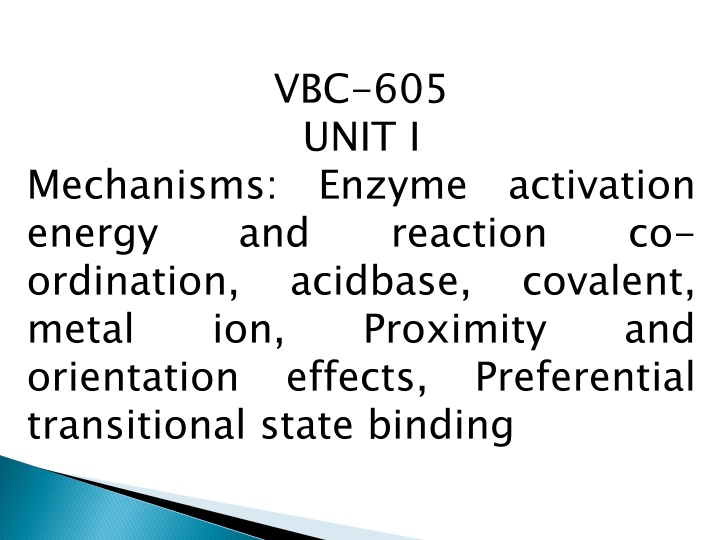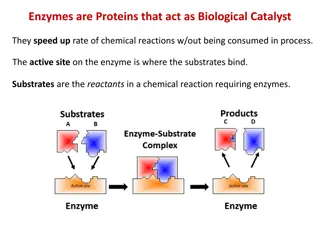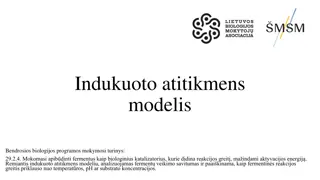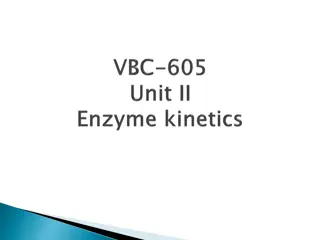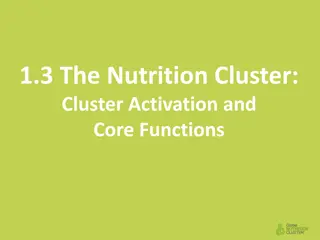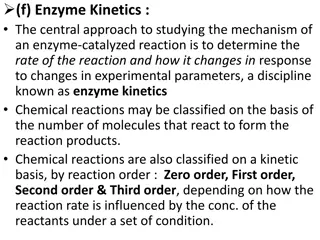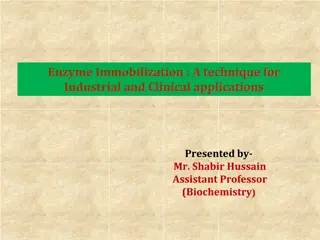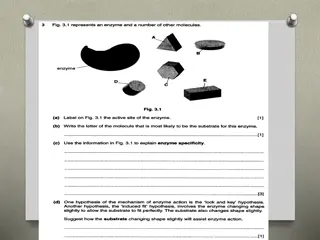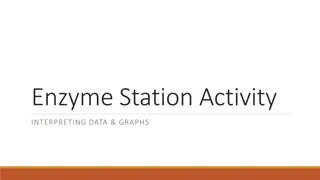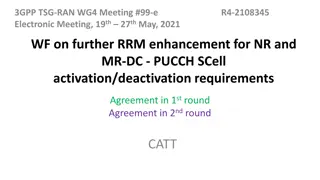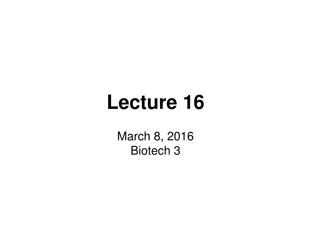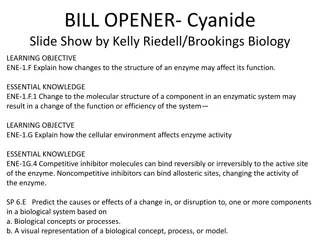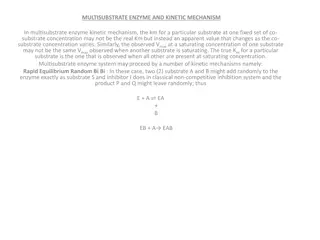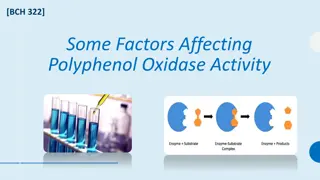Enzyme Activation Energy and Transition State
Enzymes play a crucial role in speeding up reactions by lowering the activation energy required for molecules to reach the transition state. The transition state is a high-energy, unstable state where bonds are broken and formed. This state involves interactions with the enzyme, forcing molecules through a different pathway to facilitate the reaction. Learn about the mechanisms, effects, and energy diagrams involved in enzyme catalysis.
Download Presentation

Please find below an Image/Link to download the presentation.
The content on the website is provided AS IS for your information and personal use only. It may not be sold, licensed, or shared on other websites without obtaining consent from the author.If you encounter any issues during the download, it is possible that the publisher has removed the file from their server.
You are allowed to download the files provided on this website for personal or commercial use, subject to the condition that they are used lawfully. All files are the property of their respective owners.
The content on the website is provided AS IS for your information and personal use only. It may not be sold, licensed, or shared on other websites without obtaining consent from the author.
E N D
Presentation Transcript
VBC-605 UNIT I Mechanisms: Enzyme activation energy ordination, metal orientation effects, Preferential transitional state binding and reaction co- acidbase, ion, covalent, Proximity and
Reaction Rates and the Reaction Rates and the Transition State Transition State Enzymes speed up reactions enormously. To understand how they do this, examine the concepts of activation energy & the transition state. In order to react, the molecules involved are distorted, strained or forced to have an unlikely electronic arrangement. That is the molecules must pass through a high energy state.
This high energy state is called thetransition state. The energy required to achieve it is called the activation energy for the reaction. The higher the free energy change for the transition barrier, the slower the reaction rate. Most stable product is the one with the lowest energy Energy diagram for a single-step reaction
high energy, unstable state in which a molecule is best suited to undergo a chemical reaction; state in which chemical bonds are being broken and formed. Linus Pauling that a catalyst must do is bind the transition state more tightly than the substrate Linus Pauling postulated that the only thing Old bonds break and new ones form Substance is neither substrate nor product Unstable short lived species with an equal probability of going forward or backward Strained intermediate
Enzymes lower energy barrier by forcing the reacting molecules through a different transition state. Enzyme This transition state involves interactions with the enzyme.
Floating ball analogies for enzyme catalysis
Energy diagram for reaction with intermediate Intermediated occurs in between the two transition states In this case, the rate determining step in the forward direction is formation of the second transition state
Reaction intermediate--- transient chemical species Rate limiting step Lowering activation energy is by binding energy
Modes of Enzymatic Modes of Enzymatic Enhancement of Rates Enhancement of Rates 1) general acid and general base catalysis-- good proton donors & acceptorspositioned just right. 2) covalent catalysis- unstable intermediate cysteine, serine, histidine 3) metal ion catalysis - electron donor or acceptor
General base catalysis of a reaction by transfer of a proton B: = base (proton acceptor) BH+ = conjugate acid (proton donor) A general base (B:) can act as a proton acceptor to remove protons from OH, NH, CH or other XH This produces a stronger nucleophilic reactant (X:-) General base catalysis- - acceleration
Specific Base Catalysis can remove a proton from water and thereby generate the equivalent of OH- in neutral solution Specific Base Catalysis General Acid Catalysis/ Specific Acid Catalysis Proton donors can also catalyze reactions General Acid Catalysis/ Specific Acid Catalysis Many biochemical reactions require acid base catalysis Hydrolysis of peptides Reactions with Phosphate groups Tautomerizations Additions to carboxyl groups Many biochemical reactions require acid base catalysis
involves the formation of a transient covalent bond between the catalyst and the substrate Group X can be transferred from A-X to B in two steps via the covalent ES complex X-E
either assist in the catalyic reaction, activate the enzyme to begin the catalysis can inhibit reactions in solution Common metals that take part in metal ion catalysts are copper and zinc They participate in one of three ways: a. They bind substrates to orient them for catalysis b. Through redox reactions gain or loss of electrons c. electrostatic stabilization or negative charge shielding copper and zinc ion They participate in one of three ways: a. They bind substrates to orient them for catalysis b. Through redox reactions gain or loss of electrons c. electrostatic stabilization or negative charge shielding It can stabilize the unstable transition state Metal ions are effective catalysts because unlike protons they can be present at higher concentrations at neutral pH and have charges greater than 1. Metal ions are effective catalysts because unlike protons they can be present at higher concentrations at neutral pH and have charges greater than 1.
Substrate binding has additional effects that enhance reaction rates Most obvious is proximity & orientation Reactants must come together with the proper spatial relationship for a reaction to occur Proximity effects (minor) are most readily observed by comparing equivalent inter- and intramolecular reactions Intramolecular reactions are typically 10-100 fold more rapid Orientation effects are more significant though difficult to quantify
Enzymes bind the transition state with higher affinity than the substrate or product explains why reactions proceed and products are released explains why transition state analogues are excellent competitive inhibitors together with proximity and orientation effects, accounts for bulk of rate enhancement in many enzymes Enzyme mechanically strain substrates towards transition states (rack mechanism) rate enhancement can be expressed in terms of enzyme affinity for transition state compared relative to substrate explains why good and bad substrates typically have similar Km value but different kcat values A good substrate does not need to bind tightly to the enzyme but must bind tightly when activated to the transition state
Models of Enzymatic reaction Lock & Key Model- Fischer Induced fit- Koshland enzyme changes its conformation to accept the transition state of substrate/product well. Substrate strain theory Enzyme conformational change simultaneous, works to distort and strain substrate forcing it into transition state
Expressed in terms of the activity One Enzyme that catalyzes the formation of 1 micromole of product in 1 minute Katal conversion of 1 mole of substrate to product in 1 second 1 katal = 6 X 107 international units One International International Unit Unit- - the amount of Katal- - amount of enzyme catalyzing the
